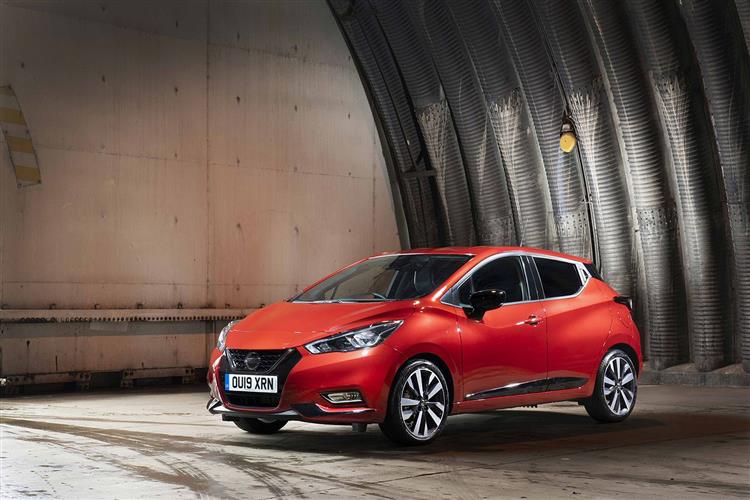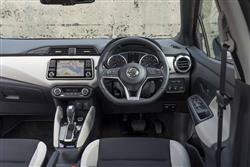MICRA-MANAGED (some text hidden) --NONE--
By Jonathan Crouch
Introductionword count: 57
In post-2016-era MK5 form, the Nissan Micra once again became a very class-competitive, characterful supermini. In this form ,it was stylish and very good to drive, while setting a high standard with its sense of safety. You know that car in this class from the 2016-2023 period you were thinking of? Stack it up against this one.
Modelsword count: 14
5dr Hatch (petrol - 1.0, 0.9 IG-T, 1.0 IG-T / diesel - 1.5 dCi)
Historyword count: 293
The MK5 Nissan Micra introduced in 2016 was a supermini with a lot to prove. Made by a brand with a lot of ground to make up in this segment. At this 'K14'-series model's launch, the company knew it had only itself to blame for this, in 2010 transferring Micra production from Sunderland in the UK to plants in India, Thailand, Mexico and Indonesia using low cost labour. Those factories were given a fourth generation'K13' model to assemble with a global remit theoretically designed to satisfy everyone, but its cheap, characterless demeanour achieved precisely the opposite result and sales sank to the bottom to the supermini segment. Belatedly, the Japanese maker then realised what most of us previously already knew; namely that the Micra was at its best when it was built and individualistically designed in Europe. The MK2 and MK3 models proved that. This MK5 version aimed to do so again. There were certainly no half-measures with the K14 version, with a full-on European design mostly engineered in the UK and built in the same French Renault plant near Paris that made that brand's rival Clio model. The Micra shared an evolved version of that car's platform too, but just about everything else here was new. The avant garde looks ushered in a completely fresh driving experience, with drive dynamics borrowed from larger models in the Nissan line-up. Hi-tech safety and media technology was democratised for use here too, plus there was a far more pleasingly designed cabin that offered more space and could be embellished with some tempting customer options. Nissan gave the gave a light facial update in 2020, about the same time that the dCi diesel version was dropped. And the MK5 Micra sold until mid-2023, then wasn't replaced.
What You Getword count: 356
If you're used to the conservative design of the old pre-2016-era fourth generation Micra, you may need to sit down and have a cup of hot sweet tea after looking at this one. Expressive and emotive, this is the kind of shape you might more readily associate with a motorshow concept car than a production model, with an athletic silhouette that's much longer, lower and wider than what was offered before. Inside up front, things were much enhanced over what went before, the fascia based around what Nissan called a 'gliding wing' dashboard layout which feels of decent quality and could from new be personalised with colour-coded versions of the centre panel. Through the 'D'-shaped multi-function steering wheel, the instrument cluster is much as you'd find it on a more expensive Qashqai crossover model from this period. The 5-inch TFT screen can be set to show everything from navigation to performance data. Anything this monitor can't tell you will probably be covered off by the 7-inch centre-dash infotainment touchscreen you get providing you avoid entry-level trim. Probably, the extra technology helps influence the greater perception of quality and our favourite touch from new was the optional 'BOSE Personal Premium Audio System' which came with two speakers actually built into the driver's head rest. In the rear seat, because of the swept-back styling, you shouldn't expect the kind of space that might be offered by a boxier-looking rival from this period like, say, a Skoda Fabia or Honda Jazz. Fortunately, as Nissan knows very well, most supermini buyers use these pews primarily for children - who'll be more than satisfied by what's on offer here. Shoulder width is also fine for two thanks to the extra 78-mm of width that this car enjoys compared to its predecessor. As for the boot, well with the rear seats in place, this Nissan offers 300-litres of cargo accommodation, which is good but nowhere near class-leading. Still, the luggage area provided here is properly-shaped to accommodate something like a fold-up buggy or the weekly shop. Of course as usual, you can extend the space available by using the 60:40-split rear seatback.
To see the full road test text contact us on 0330 0020 227
Pictures (high res disabled)

.jpg)
|
.jpg)
|
.jpg)
| |||
.jpg)
|
.jpg)
|
.jpg)
| |||

|
Scoring (subset of scores)
Category: Small Runabouts
| Performance | |
| Handling | |
| Comfort | |
| Space | |
| Styling, Build, Value, Equipment, Depreciation, Handling, Insurance and Total scores are available with our full data feed. | |



